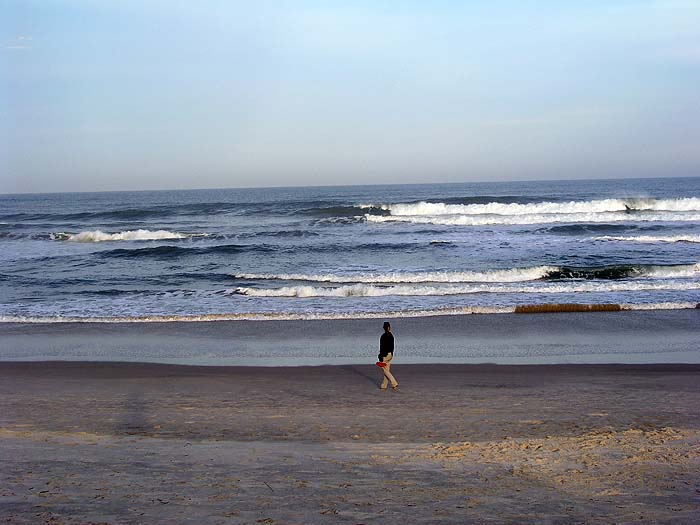Forget Rio. For pristine beaches, sultry nightlife and no crowds, head south, says Douglas Rogers.
"Who's more famous in Brazil," I ask a 62-year-old fisherman, Milton Mendoza, as he waits to cast his net in the waters off Laguna, "Pele or Galha Torta?" Milton, toothless, and wizened as a prophet, thinks for a moment and then says: "Well, in southern Brazil, they're about the same." Given that Pele is a global icon, one of the most famous men in the world, and Galha Torta is a dead bottlenose dolphin from the 1960s, that's quite something.
Galha Torta is the most renowned of the famed Laguna dolphins which, for as long as anyone can remember in this sleepy coastal town in the southern Brazilian state of Santa Catarina, have helped local fishermen lure their daily catch by literally herding shoals into their nets. The phenomenon - which also occurs in parts of West Africa but nowhere else in the world - has for years attracted marine biologists and natural historians to Laguna to study the bizarre, communal relationship.
Given how remarkable it is - the fishermen give the dolphin names, and many town folk grow up with stories of the likes of Galha Torta - one would think Santa Catarina might put on a show to promote it. Instead, the beach we're at - its causeway, and the muddy estuary along which the fishermen wait expectantly to cast their nets - is unmarked and undeveloped, and if I hadn't known to look for it here I would have driven straight past.
Which partly explains why Santa Catarina, one of the smallest and richest states in Brazil, has languished in the tourist's imagination. It doesn't like to show itself off.When we Britons think of Brazil we think Rio, São Paolo, Salvador and the beach resorts of Angra or Buzios. Until recently, few Brazilians made a point of visiting the south either. That's all changing, however. In 2001 a Brazilian magazine declared Florianópolis, Santa Catarina's island capital (70 miles north of Laguna and barely an hour's flight from São Paolo) the best and safest place to live in the country, and more than a million South Americans now holiday here each year, making it the second-most popular state in Brazil after Rio de Janeiro.
The UK tour operator Last Frontiers has included the south in its 2006 brochure, offering trips that can take in the Laguna dolphins, whale watching in the protected marine reserves off the coast, and the pristine beaches and sultry nightlife of Florianópolis, regularly described as the St Tropez of South America.I had a week in Santa Catarina but the dolphin weren't playing ball. They surfed the breakers off shore and didn't come anywhere near the estuary. Such is the fishermen's dependence on them that the dozen men on the banks didn't even bother casting their nets. "No dolphin, no fish," shrugged Milton. "They have been helping to feed us for more than 150 years. We trust them."
Laguna town had more going on. Settled by the Portuguese in 1676, and curved around a glassy lagoon, it has barely been touched by the tourist wave yet, but more than 600 of its historic buildings have been restored and declared national landmarks in recent years, and walking the cobbled streets, past freshly painted colonial homes, it occurred to me that in a few years it might become the Parati of the south, an enchanting historical town: put a boutique hotel next to the church on the square, open a stylish bar and restaurant or two on its lagoon-front Corniche, and Naomi Campbell will be around in no time.Dolphins apart, Laguna is most famous for being the home town of Anita Garibaldi (née Riberas), a beautiful young firebrand who married the Italian revolutionary Guiseppe Garibaldi in 1839, soon after he helped establish the Catarina Republic here, a region briefly independent from the Portuguese monarchy. The republic only lasted one year before it was crushed, but Anita went on to fight with Garibaldi in Uruguay and Italy before dying in the 1849 retreat from the French siege on Rome, aged only 28. Today, Laguna honours its homegirl as a kind of female Che Guevara, with a museum, several statues and tours of her family residence, the Casa de Anita. "You know," said our museum guide, "Mel Gibson wants to make her life into a very big film."
The dolphin might not have played ball, but the whales did. Leaving Laguna we drove north up the coast to Praia do Rosa - Rose Beach - a gorgeous crescent of white sand set under hills of dense Atlantic forest, where the Vida Sol e Mar eco-resort hosts Brazil's Right Whale Institute. In 2000, 90 miles of Santa Catarina coastline was declared a whale sanctuary and now, after being hunted to near extinction, scores of majestic Southern Rights have returned to breed in its bays between June and November. Vida Sol e Mar operates the best whale-watching safaris in the area, and early on our second morning six of us boarded a 30ft dinghy and hit the sea. Fishermen along the coast send word to the resort every morning about where to locate the whales and, sure enough, after 20 minutes, we came face-to-hump with two majestic beasts rolling in the swell. The whales get so close to the shore here you could hit them with a frisbee from the beach; from the boat you get close enough to count their barnacles. We saw a dozen whales in barely two hours, many with young cubs, but most spectacular of all was an albino Southern Right, its skin a ghostly grey beneath the brine. Albino whales are so rare even the marine biologist on our boat was in awe. "I've never seen one before," she said. "Never."
Look at a large-scale map of Santa Catarina and you might hazard a guess at another reason British tourists have long ignored the south: too many Germans. The Portuguese and Spanish fought over the coast in the 16th and 17th centuries, but in the 1800s thousands of German migrants settled in the rich farmland of the interior, and the map reads like Bavaria. Blumenau in the central north is a thriving German city that hosts the biggest Oktoberfest in the world outside Munich (try their superb Eisenbahn and Bierland ales). Nearby Pomerode is famed for its Bavarian architecture and accordion music; and there are towns called Alfredo Wagner and Schubert.
Our guide, Lesley Cushing, a Londoner who moved to Santa Catarina in 2003 to set up Brazil Ecojourneys, the only English-language tour operator in the state, described hiking through a remote valley and coming across a village straight out of the Rheinland. "They saw my blonde hair and started speaking German to me," she said. "Most of them had never been to Germany in their lives."
German settlers were followed by Poles, Italians and, more recently, Russians, and it's not for nothing that Santa Catarina is known as the Europe of Brazil. For years this has led people to believe it's less sexy and exotic than the rest of the country, but the discovery of a certain supermodel has helped change that. Gisele Bundchen, a product of German DNA mixed with darker Brazilian blood, might come from the neighbouring state of Rio Grande do Sul, but facsimiles of her are all over Santa Catarina. Scouts from the five model agencies in Florianópolis regularly cruise the beaches for the next blonde, honey-skinned bombshell. Couple this with rounds of the world surfing championships, and home-grown sports stars such as the tennis player Gustavo Kuerten, who still lives in Florianópolis, and Santa Catarina now has an air of sporty glamour.I found ample evidence of the glamour at Ilha do Papagaio, a serene 35-acre private island just off the coast that I checked into on my third day. The island, which is accessible only by boat, is the private home of Renato Nehto, a dashing fifth-generation German Brazilian who inherited it from his father in the early 1990s, and has turned it into a gorgeous, yet affordable beach resort.
Its 20 stand-alone bungalows were set under forests of palms and fruit trees, tropical birds fluttered between the branches, and couples from São Paolo sipped mandarin caiparinhas by the pool. In the wood-built restaurant just back from the beach Renato himself often does the cooking, and I ate the best home-farmed oysters and grilled grouper fillet of my life here. Sadly, the weather was not up to par and it rained most of my second day. "You must come back with your wife when the sun is out," he said apologetically. I eyed up the helicopter pad on the lawn next to my bungalow. Perhaps he'd fly us out in a chopper from São Paolo?Even more exclusive than Papagaio is the just-opened Ponta dos Ganchos, another half-hour drive up the coast, recently rated the best beach hotel in Brazil. Set on the high cliffs of a forested peninsula, its 20 bungalows with private plunge pools overlooked a fishing village on the Emerald Coast. Every night a candlelit table was set up for a chosen couple on a small island reached by a wooden foot bridge across from the beach. You don't even have to walk back to your room afterwards: a driver picks you up in an electric-powered golf cart that ferries guests around.
After all this, I was a little surprised to find that Florianópolis, where I ended my week, did not have hotels to match its French counterpart on the Côte d'Azur. Set on the western side of a beautiful island of lagoons, jungle-covered hills and pristine beaches just off the mainland, the city is paint-chipped and sprawling, rather out of keeping with its idyllic surroundings. Until a new Sofitel is unveiled on its waterfront you're better off staying on the quiet, ocean-facing eastern side of the island. The St Tropez comparison is inaccurate in other ways. After a day on the beach the scene decants to Lagoa de Conceição, a lagoon in the heart of the island, where the hip and the beautiful cram into chic restaurants and bars such as the Confraria das Artes, a nightclub-cum-antiques store, where everything from the couches to the paintings on the walls is for sale. It feels like a laid-back beach town and is friendlier than St Tropez.You don't have to go far on the island to find yourself the only tourist in a sleepy fishing village that has barely changed since Azorean sailors landed here 300 years ago.
Eating oysters on my own in a ramshackle café in Santo Antônio do Lisboa one night, the chic clubs of Lagoa barely 10 minutes away, it occurred to me that Santa Catarina is still not that interested in showing itself off. Perhaps, like those Laguna dolphin, it doesn't really need an audience.
Brazil basics
Getting there
Last Frontiers offers a 16-day trip to southern Brazil that includes Iguassu Falls, Praia do Rosa beach, rafting and days on a beach resort in northern Florianópolis from £2,640 per person, based on two sharing.

